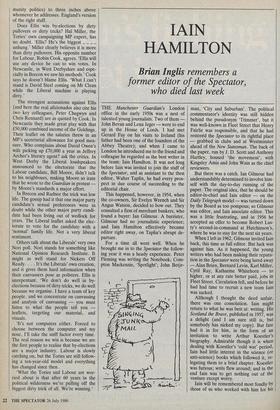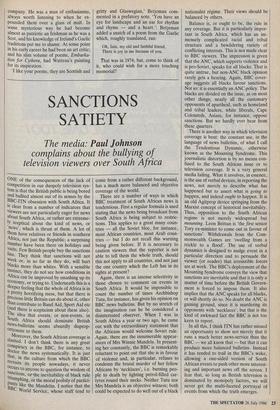IAIN HAMILTON
Brian Inglis remembers a
former editor of the Spectator, who died last week
THE Manchester Guardian's London office in the early 1950s was a nest of talented young journalists. Two of them John Bevan and Lena Jeger were to end up in the House of Lords. I had met Gerard Fay on his visits to Ireland (his father had been one of the founders of the Abbey Theatre); and when I came to London he introduced me to the friend and colleague he regarded as the best writer in the team: lain Hamilton. It was not long before Iain was invited to join the staff of the Spectator, and as assistant to the then editor, Walter Taplin, he had every pros- pect in due course of succeeding to the editorial chair.
This happened, however, in 1954, when the co-owners, Sir Evelyn Wrench and Sir Angus Watson, decided to bow out. They consulted a firm of merchant bankers, who found a buyer: Ian Gilmour. A barrister, Gilmour had no journalistic experience; and lain Hamilton effectively became editor right away, on Taplin's abrupt de- parture.
For a time all went well. When he brought me in to the Spectator the follow- ing year it was a heady experience. Peter Fleming was writing the Notebook; Corn- pton Mackenzie, `Spotlight'; John Betje- man, 'City and Suburban'. The political commentator's identity was still hidden behind the pseudonym 'Trimmer', but it was well-known in Fleet Street that Henry Fairlie was responsible, and that he had restored the Spectator to its rightful place — grabbed in clubs and at Westminster ahead of the New Statesman. The back of the paper, run by J. D. Scott and Anthony Hartley, housed 'the movement', with Kingsley Amis and John Wain as the chief reviewers.
But there was a catch. Ian Gilmour had understandably determined to involve him- self with the day-to-day running of the paper. The original idea, that he should be editor-in-chief and kin editor — on the Daily Telegraph model—was turned down by the Board as too pompous; so Gilmour was editor, and lain associate editor. This was a little frustrating, and in 1956 he accepted an offer to become Robert Lus- ty's second-in-command at Hutchinson's, where he was to stay for the next six years.
When I left in 1962, Gilmour invited Iain back, this time as full editor. But luck was against him. As it happened, the young writers who had been making their reputa- tion in the Spectator were being lured away — Alan Brien, Bernard Levin, Karl Miller, Cyril Ray, Katharine Whitehom — to higher, or at any rate better paid, jobs in Fleet Street. Circulation fell, and before he had had time to recruit a new team Iain was sacked.
Although I thought the deed unfair, there was one consolation. kin might return to what he was best at: writing. His Scotland the Brave, published in 1957, was a delight (and I am sure still is, but somebody has nicked my copy). But fate had it in for him, in the form of an invitation to write Arthur Koestler's biography. Admirable though it is when dealing with Koestler's 'cold war' period, lain had little interest in the science (or anti-science) books which followed it, re- legating them to a brief chapter. Koestler was furious; writs flew around; and in the end lain was to get nothing out of the venture except worry.
Iain will be remembered most fondly by those of us who worked with him for his company. He was a man of enthusiasms, always worth listening to when he ex- pounded them over a glass of malt. In some mysterious way he -had become almost as patriotic an Irishman as he was a Scot, and his knowledge of Ireland's Gaelic traditions put me to shame. At some point in his early career he had been an art critic; and his slim volume of poems, Embarka- tion for Cythera, had Watteau's painting for its inspiration.
`I like your poems; they are Scottish and gritty and Glaswegian,' Betjeman com- mented in a prefatory note. 'You have an eye for landscape and an ear for rhythm and rhyme — and a heart.': Betjeman added a snatch of a poem from the Gaelic which, roughly translated, ran: Oh, lain, my old and faithful friend, There is joy in me because of you.
That was in 1974; but, come to think of it, who could wish for a more touching memorial?



















































 Previous page
Previous page